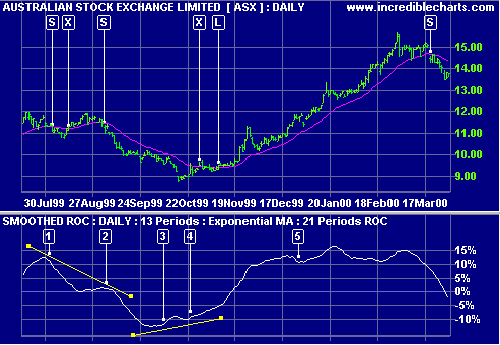Smoothed Rate of Change
Smoothed Rate of Change was first introduced by Fred G Schutzman in Futures magazine, April 1991. The oscillator performs a similar function to the Momentum and Rate Of Change indicators but avoids some of the weaknesses:
- Because of the smoothing the indicator is less erratic and gives fewer false signals;
- The exponential moving average ensures that the indicator only "barks" once. See Momentum for more detail.
Smoothed Rate of Change (SROC) first calculates a 13-day exponential moving average of closing price. Then calculate a 21-day Rate of Change of the exponential moving average.
Trading Signals
Trading rules are similar to Momentum and Rate Of Change.
Trending Markets
First, identify the trend direction using a trend indicator. Smoothed Rate of Change tends to stay above zero during an up-trend and below zero during a down-trend.
Only take signals in the direction of the trend.
- In an up-trend, go long if SROC turns upwards when below zero.
- In a down-trend, go short if SROC turns downward when above zero.
Divergences add strength to buy and sell signals.
Exit using a trend indicator.
Use trailing buy and sell stops to time your entry and exit.
Example
Australian Stock Exchange Limited (ASX) is shown with 21-day exponential moving average (EMA) and Smoothed Rate of Change.

Mouse over chart captions to display trading signals.
- Go short [S] when SROC turns down while above zero. Wait for the EMA to turn downwards. Exit the trade [X] when price closes above the EMA.
- Go short [S] when SROC again turns down while above zero, completing a bearish divergence. Wait for the EMA to turn downwards. Exit the short trade [X] when price closes above the EMA.
- SROC turns up while below zero. No action is taken as the EMA continues to slope downwards.
- Go long [L] when SROC turns up while below zero, completing a bullish divergence. Wait for the EMA to turn upwards.
- SROC turns down while above zero but the EMA continues to rise. Exit the long trade and go short at [S] when price eventually closes below the EMA.
Setup
See Indicator Panel for directions on how to set up an indicator. The default settings for Smoothed Rate of Change are:
- 13-day exponential moving average; and
- 21-day rate of change.
To alter the default settings - Edit Indicator Settings.

Author: Colin Twiggs is a former investment banker with almost 40 years of experience in financial markets. He co-founded Incredible Charts and writes the popular Trading Diary and Patient Investor newsletters.
Using a top-down approach, Colin identifies key macro trends in the global economy before evaluating selected opportunities using a combination of fundamental and technical analysis.
Focusing on interest rates and financial market liquidity as primary drivers of the economic cycle, he warned of the 2008/2009 and 2020 bear markets well ahead of actual events.
He founded PVT Capital (AFSL No. 546090) in May 2023, which offers investment strategy and advice to wholesale clients.
